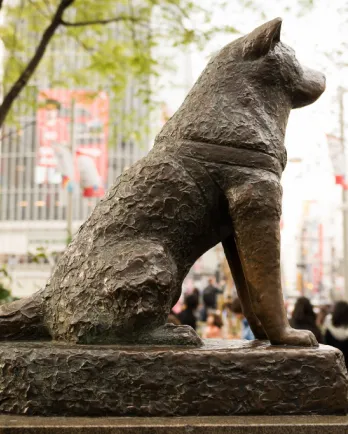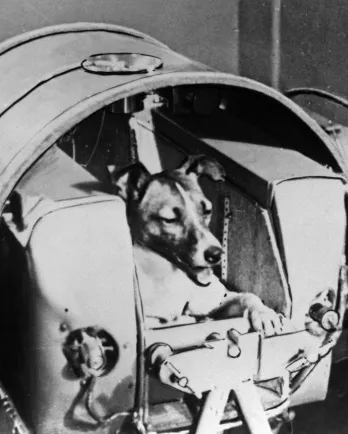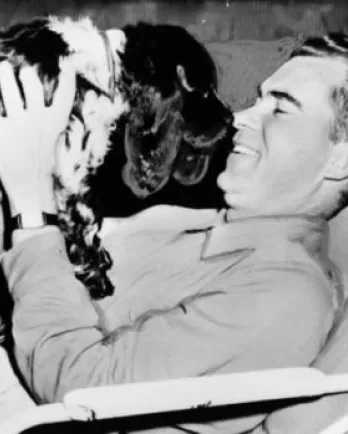The Dogs of Olde: Notable Dogs in History by Katie Kapro
Most of us, whether we’ll admit it in a public forum or not, think our dogs deserve to be famous—either for their weirdness, their cute expressions, their loyalty, or their funny habits. (Thus, internet sensations like the aww subreddit). Add that to the fact that their quirks only increase with age and become more endearing to our oh-so susceptible hearts, and we’re putty in their paws. They are celebrities in our eyes.
In honor of our unsung heroes—the ones staring over your laptop right now or barking at the meerkats on TV—let us celebrate some of the qualities that have catapulted other dogs into the annals of history.
What does it take for a dog to be a cultural icon?
Attitude
In 1920s Paris, society women liked two things: dogs and fashion. They liked to flaunt around the city with ensembles of big, protective dogs. Taking note of this trend, in 1923 Hermès of Paris created a studded luxury dog collar for one lucky client’s bulldog. In truth, the move wasn’t that unconventional considering Hermès was first established as a harness making shop, but either way, the collars took Paris by storm.
Fashion designers of the day even began buying the hardware-laden dog collars and wearing them as belts. I’m not sure if that says more about the popularity of the collars or the scant eating habits of Parisian designers, but that’s a topic for another time. Needless to say, the popularity of the Collier de Chien (CDC) grew and grew, and it quickly became a permanent piece in the Hermès collection.
Heart-Wrenching Loyalty
Hachiko the Akita inu is so famous in Japan that a museum was built in his honor. His story also began in the 1920s (who knew the ’20s were the golden era for pups?) when his human, Professor Hidesamuro Ueno, began taking the train from Shibuya Station in Tokyo to teach at the university. Hachiko made it a habit to meet Ueno at the train station every day at 4 p.m. after work and walk him home. One day, Ueno suffered a cerebral hemorrhage and did not return to the station. Hachiko continued his daily walk to the train station to meet Ueno for 10 years, until his death in 1935.Hachiko is called the world’s most loyal dog. His story has been commemorated in children’s books, film, and sculpture.
Style (and a Flat-Iron)
If the dog world had pop icons, the Westminster Dog Show would be their version of the Grammys. Who am I kidding? They do. And it is.
The supermodels of the dog world have a whole team of groomers primping and prepping them before the show. They run on doggie treadmills, sit while their locks are blow-dried, and get brushed to their heart’s content. The first Westminster Dog Show took place in 1877—it has been creating pup icons ever since.
Sacrifice
Most everyone remembers Laika, the Russian cosmonaut dog. She was the first living animal to be launched into orbit. Hers is far from an uplifting story though, because when she was launched into orbit on Nov. 3, 1957, Russian scientists hadn’t yet figured out how to engineer a return trip.
Laika was one of 36 stray dogs the Soviets sent into space on test missions, and the first to go beyond the Earth’s orbit. The dogs were chosen for their size, temperament, and, sadly, absence of families.
Self-Actualization
Sometimes all it takes for a dog to become a cultural icon is a very creative fiction writer. In her novel Lives of the Monster Dogs, author Kirsten Bakis creates a world where a loyal team of dog soldiers—Pinschers, German shepherds, Dobermans, and the like—develop into a hyper-intelligent society of canines who speak fluent German (with help from a mechanical voice box), walk upright, and wear fashionable 1800s era clothing. It’s worth noting that their physiological development had the help of a mad scientist (of course). They struggle with what it means to be a Monster Dog, and just how they fit into human society.
Political Savvy
Not all dogs find themselves born into a family of mad scientist-influenced canines. Sometimes, they just get “gifted” into fame.
When the press first started grilling vice presidential candidate Richard Nixon (who later became president) for accepting private campaign donations, he had to explain on television that he would not be giving back one of the donations, a black and white cocker spaniel named Checkers.
As a sidenote, Nixon delivered what’s come to be known as the “Checkers Speech” on Sept. 23, 1952, and that day is now designated as Dogs in Politics Day.
What qualities does your senior dog have that will make him or her as famous as Checkers?






